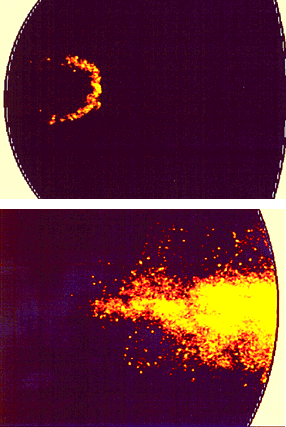
John Dec of Combustion in Engines Dept. 8362 has already shed light on fuel distribution and soot formation during diesel combustion, changing old assumptions with new data from laser diagnostics. (A special research engine equipped with quartz windows in the combustion chamber is used for these investigations.) Recently, John and colleagues turned to NO, which is either formed rapidly in the flame zone, or more slowly in the adjacent gases as a result of high temperatures generated by combustion.
INSIDE ENGINE – Planar laser-induced fluorescence imaging data show no nitric oxide in premixed burn. Instead, they show that NO first appears at the edges of the diffusion flame (top image). As the fuel jet burns out, more NO forms in the hot gases in wake of the flame (bottom image).
They developed, for the first time, a way to produce "snapshots" (instantaneous planar images) of NO in the cylinder of a diesel engine at realistic operating conditions. Although planar laser-induced fluorescence imaging has been used in other applications for several years, previous attempts to apply it to diesel combustion relied on either altering the combustion process to boost the signal or averaging the signal over multiple engine cycles, which limited the usefulness of the data.
"To obtain these single-shot images, we pioneered the use of a new technology to provide high-energy laser pulses at the required wavelength," John says. "Although we had to spend considerable time working the bugs out, this new laser system, combined with our spectroscopic technique, has allowed us to acquire images that are substantially better."
Systematically map the distribution
After demonstrating the imaging technique, John and his colleagues systematically mapped the in-cylinder NO distribution. They collected data throughout the combustion duration and in the post-combustion gases using three different laser-sheet orientations to cover the NO formation process during diesel combustion.
Unlike gasoline engines, which require a spark, diesel engines use compression heating of the in-cylinder air to initiate combustion. The diesel fuel is injected into the hot air and "autoignites" shortly after vaporizing and mixing with the air. After ignition, the premixed fuel burns rapidly, then the remainder of the fuel burns as it mixes with the air, with most combustion occurring in a diffusion flame.
"Most diesel experts thought that autoignition and the initial premixed burning occurred in areas that had a nearly ideal fuel-air ratio," John says. "As a result, they expected this process to produce a lot of nitric oxide." However, John’s previous research had shown that the premixed burn was actually fuel-rich. When excess fuel is present, temperatures and oxygen content are too low for significant NO formation.
The recent NO imaging data confirm this, showing no nitric oxide forming in the premixed burn. Instead, they show that NO first appears at the edge of the diffusion flame. As the fuel jet burns out, more NO forms in the hot gases in wake of the flame.
Half forms away from flame zones
"Almost half of the NO forms in the hot gases away from the flame zones, or after the flame goes out," John says. He carefully analyzed and corrected the raw data to obtain a quantitative plot of NO formation during diesel combustion. With help from Combustion Research Facility colleague Phil Paul (8351), he took into account factors that affect the raw signal and was able to bracket the actual NO formation within relatively narrow limits.
"This information will be helpful to engine designers who are trying to reduce emissions," he says. There is a trade-off between reducing emissions of soot or the oxides of nitrogen (NOx) because generating more heat to burn up the soot can also produce more NO, the precursor of the NOx species measured in tailpipe emissions tests.
"Much of NO is forming after the soot is already oxidized," he says, "so the temperature could be lowered using gas-mixing techniques, to stop the NO formation."
One technique being explored, already employed in spark-ignition gasoline engines, is to recirculate exhaust gas into the cylinder, where it absorbs some of the heat and lowers the combustion temperature.
John recently presented this research at the annual meeting of the Society of Automotive Engineers in Detroit. He carried out the work with Eldon Porter and postdoctoral employee Robert Canaan (both 8362) as part of an ongoing cooperative research and development agreement with heavy-duty diesel manufacturers Cummins, Caterpillar, and Detroit Diesel.
Overall, John says, "Nobody really understood where and when NO formed during diesel combustion."
The results of this NO imaging investigation support the new picture of diesel combustion that John previously developed based on earlier laser-diagnostic studies in this engine, and they will help numerical modelers refine their predictive codes.